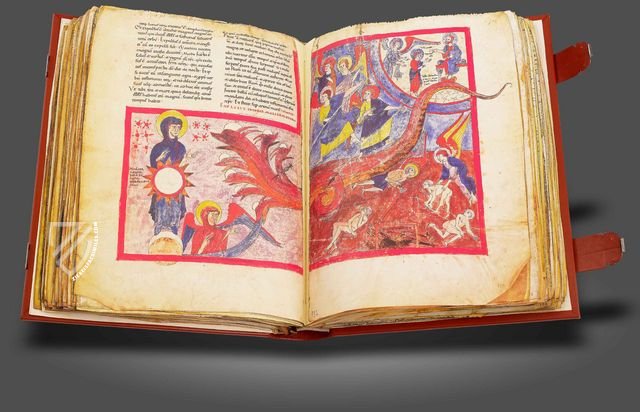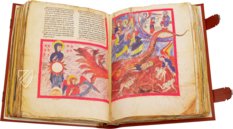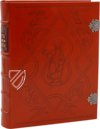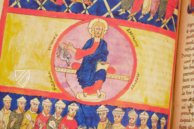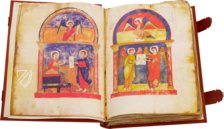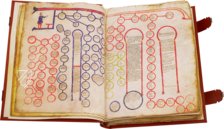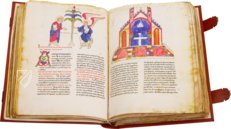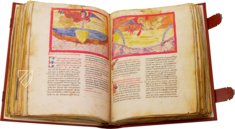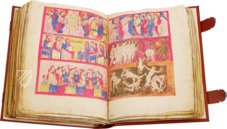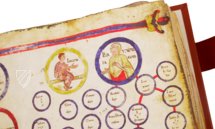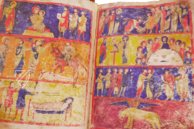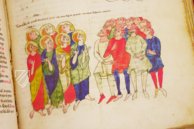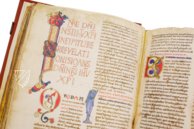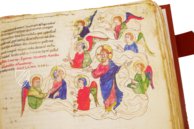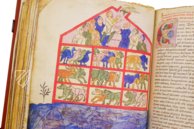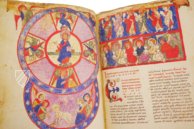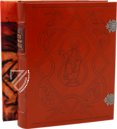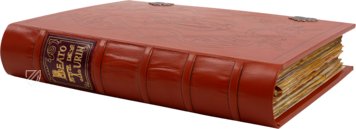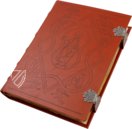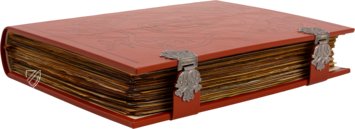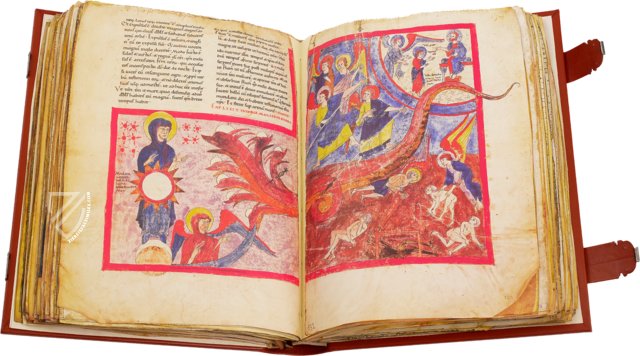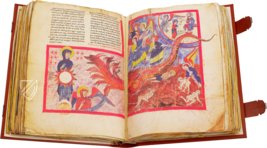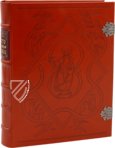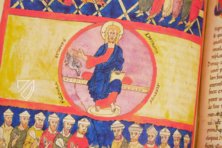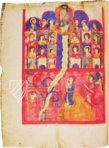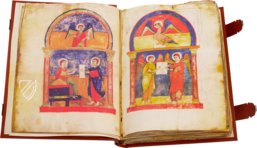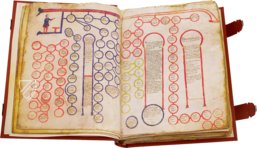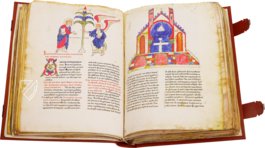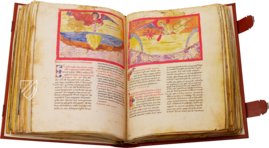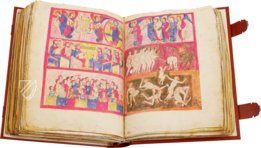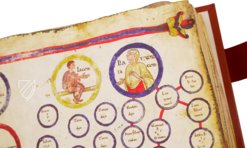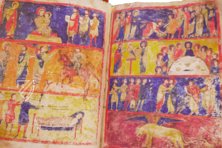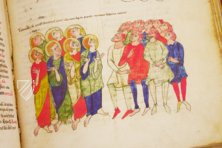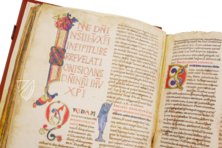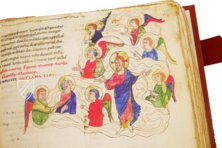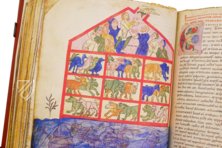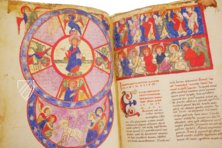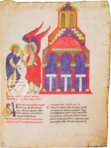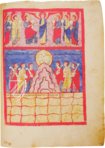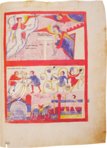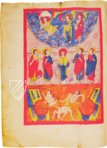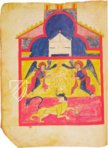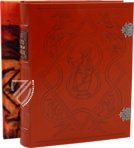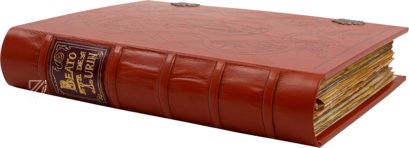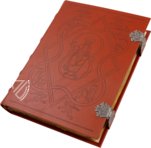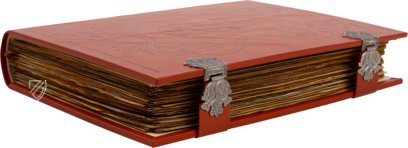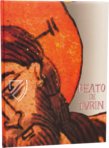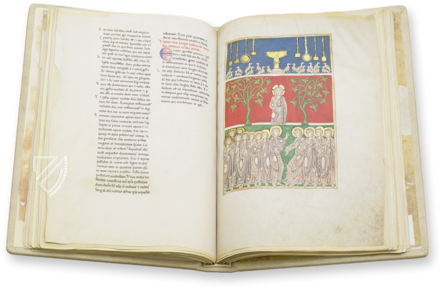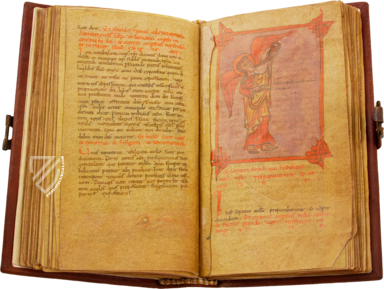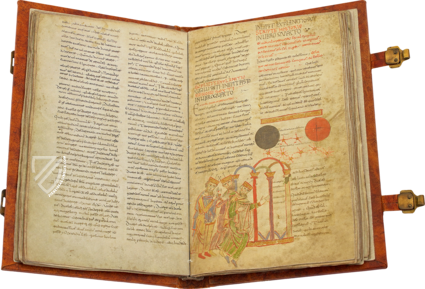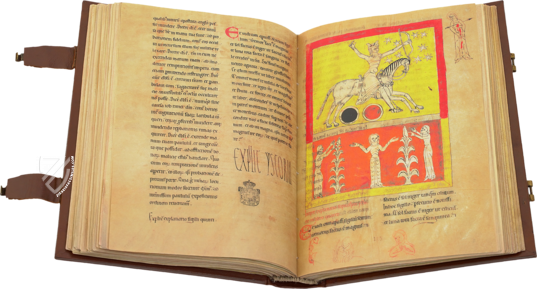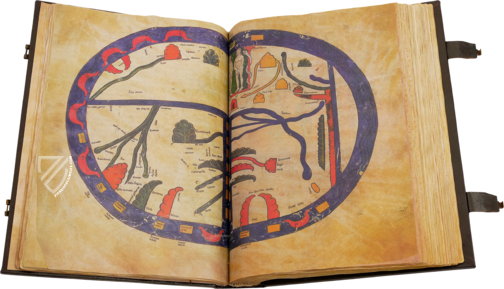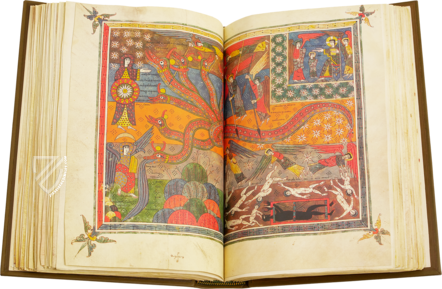Beatus of Liébana - Turin Codex
(3,000€ - 7,000€)
The so-called Turin Codex is a Beatus manuscript originating in Catalonia ca. 1100. The 106 miniatures in total are of outstanding quality, which present innovative pictorial inventions in some places – e.g. the famous round world map. The Turin Codex is an unmediated copy of the famous Girona Codex, which was made in the year 975 in the groundbreaking scriptorium of the Monastery of San Salvador de Tábara. As such, the Turin codex stands in the tradition of “one of the most important manuscripts of all time”!
Beatus of Liébana - Turin Codex
The so-called Turin Codex is a Beatus manuscript originating in Catalonia ca. 1100. The 106 miniatures in total are of outstanding quality, which present innovative pictorial inventions in some places – e.g. the famous round world map. The Turin Codex is an unmediated copy of the famous Girona Codex, which was made in the year 975 in the groundbreaking scriptorium of the Monastery of San Salvador de Tábara. As such, the Turin codex stands in the tradition of “one of the most important manuscripts of all time”!
The Vision of the End of the World
The Apocalypse Commentary by Beatus of Liébana (deceased after 798) was a bestseller of the High Middle Ages. The monk and theologian from the Monastery of San Martin der Turieno near Liébana wrote his influential work: a commentary to the Apocalypse of John ca. 800. The biblical tale of the end of the world was especially popular and influential throughout the Middle Ages, wherefore the Commentary of Beatus of Liébana enjoyed widespread popularity and dissemination. Beatus composed his clarifying and interpretive commentary on John’s symbolically-charged vision in twelve books. These clarifying texts were recorded in numerous, for the most part wonderfully illustrated, large-format manuscripts, of which over 30 specimens still exist today. These belong among the most significant manuscripts of the Middle Ages in northern Spain and are true treasures of illumination!
The Copy of a Masterpiece
The Turin Codex, named after its modern repository, contains a total of 106 miniatures of outstanding quality across 428 pages. The manuscript probably originates ca. 1100 in Catalonia, presumably in Ripoll in the province of Girona. The scriptorium of Ripoll was a site of outstanding artistic production at this time and developed under the famous Abbot Oliba into a center of scholarship and the arts. A direct copy of the famous Girona codex originated from there.
Groundbreaking Pictorial Inventions in Compelling Quality
This Girona Codex is stored today in the archive of the Girona Cathedral. It originated in the second half of the 10th century, probably in the year 975. The scribes, miniaturists (including one female!), and commissioner of the Girona Codex are all known, they are all mentioned in the codex. The exceedingly valuable and exceptional codex, adorned in splendid gold and silver, contains depictions that are to be found in no other Beatus, e.g. scenes from the life of Christ in the form of an image cycle. At times the artist would work with typical motifs, but nevertheless in outstanding quality, at other times they would employ completely new, unique iconography. The Girona Beatus probably originated from the Monastery of San Salvador de Tábara and is considered to be “one of the most important Spanish manuscripts of all time”, and that very masterpiece was used as a template by the artists of the Turin Codex for their own work of art!
Codicology
- Alternative Titles
- Beatus von Liébana - Turiner Codex
Beato de Turín
Turiner Beatus - Size / Format
- 428 pages / 36.0 × 27.5 cm
- Origin
- Spain
- Date
- 12th century
- Epochs
- Style
- Genre
- Language
- Illustrations
- 106 miniatures (93 in the Beatus Commentary and another 13 in the Book of Daniel)
- Artist / School
- Beatus of Liébana (died after 798) (author)
Modelled on the Girona Beatus
Beatus of Liébana - San Miguel de Escalada Codex
Christ in Majesty
Seated within an elaborate mandorla, we see Christ enthroned as ruler of the world. In fact, he holds the world, labelled Mundi, between the thumb and ring finger of his right hand while holding a book in his left. Christ’s face is stern, a reflection of the divine wrath described in the Book of Revelation, and looks directly out at the reader as if he were prompting them to examine their own souls. Great attention to detail has been paid to the fall of folds in his dark blue tunic.
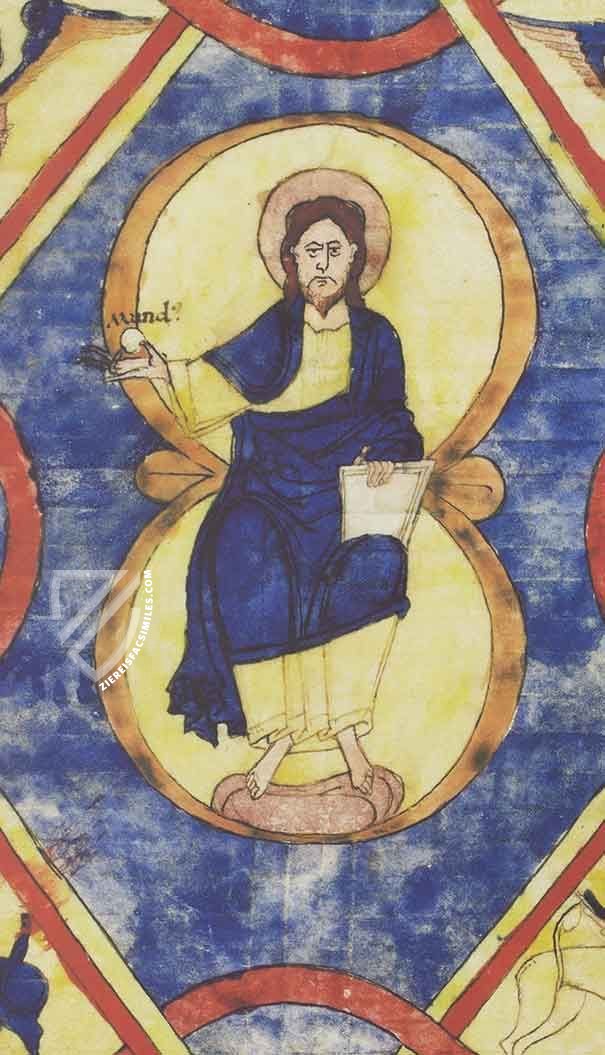
Beatus of Liébana - Turin Codex
The Woman and the Dragon
The Woman of the Apocalypse is one of the most prominent figures of John’s Revelation and is widely considered to be either the Virgin Mary or God’s people as a whole. In this grand double-page miniature, she appears at the far left clothed in the sun, the moon at her feet, and crowned with twelves stars (although the artist appears to have forgotten two) as the red, seven-headed dragon who wants to devour her child stretches across both pages.
God saves the child, who is pictured with him in the upper right, but this provokes the War in Heaven. Spear-wielding angels commanded by the Archangel Michael descend upon the dragon, representing Satan, who is defeated and cast down along with his fallen angels – depicted as being naked, having been stripped of their fair hue.
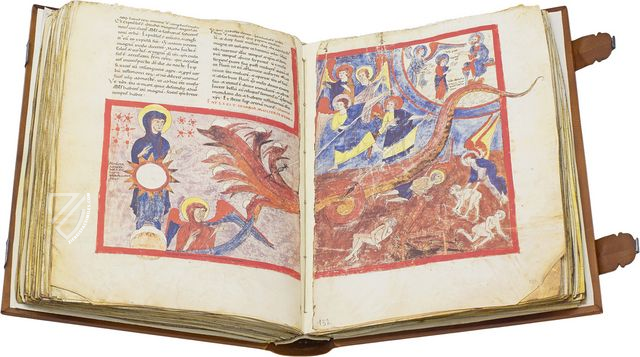
#1 Beato de Turín
Language: Spanish
(3,000€ - 7,000€)
- Treatises / Secular Books
- Apocalypses / Beatus
- Astronomy / Astrology
- Bestiaries
- Bibles / Gospels
- Chronicles / History / Law
- Geography / Maps
- Saints' Lives
- Islam / Oriental
- Judaism / Hebrew
- Single Leaf Collections
- Leonardo da Vinci
- Literature / Poetry
- Liturgical Manuscripts
- Medicine / Botany / Alchemy
- Music
- Mythology / Prophecies
- Psalters
- Other Religious Books
- Games / Hunting
- Private Devotion Books
- Other Genres
- Afghanistan
- Armenia
- Austria
- Belgium
- Belize
- Bosnia and Herzegovina
- China
- Colombia
- Costa Rica
- Croatia
- Cyprus
- Czech Republic
- Denmark
- Egypt
- El Salvador
- Ethiopia
- France
- Germany
- Greece
- Guatemala
- Honduras
- Hungary
- India
- Iran
- Iraq
- Israel
- Italy
- Japan
- Jordan
- Kazakhstan
- Kyrgyzstan
- Lebanon
- Liechtenstein
- Luxembourg
- Mexico
- Morocco
- Netherlands
- Palestine
- Panama
- Peru
- Poland
- Portugal
- Romania
- Russia
- Serbia
- Spain
- Sri Lanka
- Sweden
- Switzerland
- Syria
- Tajikistan
- Turkey
- Turkmenistan
- Ukraine
- United Kingdom
- United States
- Uzbekistan
- Vatican City
- A. Oosthoek, van Holkema & Warendorf
- Aboca Museum
- Ajuntament de Valencia
- Akademie Verlag
- Akademische Druck- u. Verlagsanstalt (ADEVA)
- Aldo Ausilio Editore - Bottega d’Erasmo
- Alecto Historical Editions
- Alkuin Verlag
- Almqvist & Wiksell
- Amilcare Pizzi
- Andreas & Andreas Verlagsbuchhandlung
- Archa 90
- Archiv Verlag
- Archivi Edizioni
- Arnold Verlag
- ARS
- Ars Magna
- ArtCodex
- AyN Ediciones
- Azimuth Editions
- Badenia Verlag
- Bärenreiter-Verlag
- Belser Verlag
- Belser Verlag / WK Wertkontor
- Benziger Verlag
- Bernardinum Wydawnictwo
- BiblioGemma
- Biblioteca Apostolica Vaticana (Vaticanstadt, Vaticanstadt)
- Bibliotheca Palatina Faksimile Verlag
- Bibliotheca Rara
- Boydell & Brewer
- Bramante Edizioni
- Bredius Genootschap
- Brepols Publishers
- British Library
- C. Weckesser
- Caixa Catalunya
- Canesi
- CAPSA, Ars Scriptoria
- Caratzas Brothers, Publishers
- Carus Verlag
- Casamassima Libri
- Centrum Cartographie Verlag GmbH
- Chavane Verlag
- Christian Brandstätter Verlag
- Circulo Cientifico
- Club Bibliófilo Versol
- Club du Livre
- CM Editores
- Collegium Graphicum
- Collezione Apocrifa Da Vinci
- Comissão Nacional para as Comemorações dos Descobrimentos Portugueses
- Coron Verlag
- Corvina
- CTHS
- D. S. Brewer
- Damon
- De Agostini/UTET
- De Nederlandsche Boekhandel
- De Schutter
- Deuschle & Stemmle
- Deutscher Verlag für Kunstwissenschaft
- DIAMM
- Droz
- E. Schreiber Graphische Kunstanstalten
- Ediciones Boreal
- Ediciones Grial
- Ediclube
- Edições Inapa
- Edilan
- Editalia
- Edition Deuschle
- Edition Georg Popp
- Edition Leipzig
- Edition Libri Illustri
- Editiones Reales Sitios S. L.
- Éditions de l'Oiseau Lyre
- Editions Medicina Rara
- Editorial Casariego
- Editorial Mintzoa
- Editrice Antenore
- Editrice Velar
- Edizioni Edison
- Egeria, S.L.
- Eikon Editores
- Electa
- Emery Walker Limited
- Enciclopèdia Catalana
- Eos-Verlag
- Ephesus Publishing
- Ernst Battenberg
- Eugrammia Press
- Extraordinary Editions
- Fackelverlag
- Facsimila Art & Edition
- Facsimile Editions Ltd.
- Facsimilia Art & Edition Ebert KG
- Faksimile Verlag
- Feuermann Verlag
- Folger Shakespeare Library
- Franco Cosimo Panini Editore
- Friedrich Wittig Verlag
- Fundación Hullera Vasco-Leonesa
- G. Braziller
- Gabriele Mazzotta Editore
- Gebr. Mann Verlag
- Gesellschaft für graphische Industrie
- Getty Research Institute
- Giovanni Domenico de Rossi
- Giunti Editore
- Graffiti
- Grafica European Center of Fine Arts
- Guido Pressler
- Guillermo Blazquez
- Gustav Kiepenheuer
- H. N. Abrams
- Harrassowitz
- Harvard University Press
- Helikon
- Hendrickson Publishers
- Henning Oppermann
- Herder Verlag
- Hes & De Graaf Publishers
- Hoepli
- Holbein-Verlag
- Houghton Library
- Hugo Schmidt Verlag
- Idion Verlag
- Il Bulino, edizioni d'arte
- ILte
- Imago
- Insel Verlag
- Insel-Verlag Anton Kippenberger
- Instituto de Estudios Altoaragoneses
- Instituto Nacional de Antropología e Historia
- Introligatornia Budnik Jerzy
- Istituto dell'Enciclopedia Italiana - Treccani
- Istituto Ellenico di Studi Bizantini e Postbizantini
- Istituto Geografico De Agostini
- Istituto Poligrafico e Zecca dello Stato
- Italarte Art Establishments
- Jan Thorbecke Verlag
- Johnson Reprint Corporation
- Josef Stocker
- Josef Stocker-Schmid
- Jugoslavija
- Karl W. Hiersemann
- Kasper Straube
- Kaydeda Ediciones
- Kindler Verlag / Coron Verlag
- Kodansha International Ltd.
- Konrad Kölbl Verlag
- Kurt Wolff Verlag
- La Liberia dello Stato
- La Linea Editrice
- La Meta Editore
- Lambert Schneider
- Landeskreditbank Baden-Württemberg
- Leo S. Olschki
- Les Incunables
- Liber Artis
- Library of Congress
- Libreria Musicale Italiana
- Lichtdruck
- Lito Immagine Editore
- Lumen Artis
- Lund Humphries
- M. Moleiro Editor
- Maison des Sciences de l'homme et de la société de Poitiers
- Manuscriptum
- Martinus Nijhoff
- Maruzen-Yushodo Co. Ltd.
- MASA
- Massada Publishers
- McGraw-Hill
- Metropolitan Museum of Art
- Militos
- Millennium Liber
- Müller & Schindler
- Nahar - Stavit
- Nahar and Steimatzky
- National Library of Wales
- Neri Pozza
- Nova Charta
- Oceanum Verlag
- Odeon
- Orbis Mediaevalis
- Orbis Pictus
- Österreichische Staatsdruckerei
- Oxford University Press
- Pageant Books
- Parzellers Buchverlag
- Patrimonio Ediciones
- Pattloch Verlag
- PIAF
- Pieper Verlag
- Plon-Nourrit et cie
- Poligrafiche Bolis
- Presses Universitaires de Strasbourg
- Prestel Verlag
- Princeton University Press
- Prisma Verlag
- Priuli & Verlucca, editori
- Pro Sport Verlag
- Propyläen Verlag
- Pytheas Books
- Quaternio Verlag Luzern
- Reales Sitios
- Recht-Verlag
- Reichert Verlag
- Reichsdruckerei
- Reprint Verlag
- Riehn & Reusch
- Roberto Vattori Editore
- Rosenkilde and Bagger
- Roxburghe Club
- Salerno Editrice
- Saltellus Press
- Sandoz
- Sarajevo Svjetlost
- Schöck ArtPrint Kft.
- Schulsinger Brothers
- Scolar Press
- Scrinium
- Scripta Maneant
- Scriptorium
- Shazar
- Siloé, arte y bibliofilia
- SISMEL - Edizioni del Galluzzo
- Sociedad Mexicana de Antropología
- Société des Bibliophiles & Iconophiles de Belgique
- Soncin Publishing
- Sorli Ediciones
- Stainer and Bell
- Studer
- Styria Verlag
- Sumptibus Pragopress
- Szegedi Tudomànyegyetem
- Taberna Libraria
- Tarshish Books
- Taschen
- Tempus Libri
- Testimonio Compañía Editorial
- Thames and Hudson
- The Clear Vue Publishing Partnership Limited
- The Facsimile Codex
- The Folio Society
- The Marquess of Normanby
- The Richard III and Yorkist History Trust
- Tip.Le.Co
- TouchArt
- TREC Publishing House
- TRI Publishing Co.
- Trident Editore
- Tuliba Collection
- Typis Regiae Officinae Polygraphicae
- Union Verlag Berlin
- Universidad de Granada
- University of California Press
- University of Chicago Press
- Urs Graf
- Vallecchi
- Van Wijnen
- VCH, Acta Humaniora
- VDI Verlag
- VEB Deutscher Verlag für Musik
- Verlag Anton Pustet / Andreas Verlag
- Verlag Bibliophile Drucke Josef Stocker
- Verlag der Münchner Drucke
- Verlag für Regionalgeschichte
- Verlag Styria
- Vicent Garcia Editores
- W. Turnowski Ltd.
- W. Turnowsky
- Waanders Printers
- Wiener Mechitharisten-Congregation (Wien, Österreich)
- Wissenschaftliche Buchgesellschaft
- Wissenschaftliche Verlagsgesellschaft
- Wydawnictwo Dolnoslaskie
- Xuntanza Editorial
- Zakład Narodowy
- Zollikofer AG

